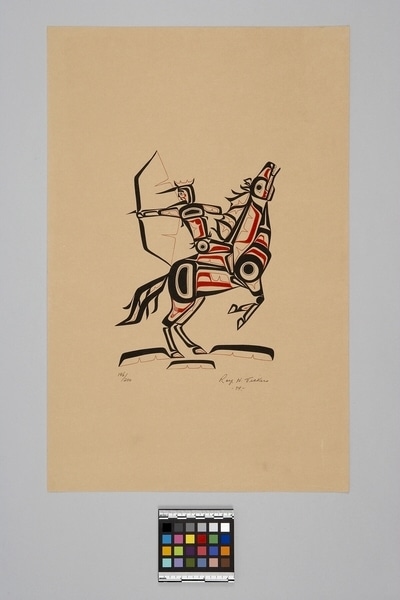Print Item Number: Nb7.226 from the MOA: University of British Columbia

Description
Silkscreen print design of a horse and rider. Both figures are in profile with the horse facing to the right side while the rider is facing to the left side. The horse has its head pointing upward at an angle with its front legs are up in the air while its back legs are on the ground. The horse has a circular black eye outlined by a tapering oval. There are two red u forms below the eye. The top of the snout has an upside down red u form. The open mouth has three upper teeth with an upside down red split u behind. The neck has a red split u and a double-notched split u. The ches has red u forms and a blank T-shape. The front joint is a black circle in a circle in a circle. The front legs have red split u's. The belly has two red u forms and a red split u. The back joint is a black ovoid. back legs have red u forms and a red split u. The mane and tail are flowing. The horse is outlined by black. The rider has a circular black eye outlined by a tapering oval with black brows above, red u forms, and a black L-shape on the face. The arms have red split u's, and they are pointing a bow and arrow behind him to the left side. The ground has three red and black double-notched split u's. Black ink inscription along the bottom reads '196/200 Roy H. Vickers 74'. The print is on a vertically rectangular, brown paper piece.
History Of Use
Silk-screen prints are a major form of contemporary Indian art. Silk-screen printing emerged in the 1950's as a new non-traditional art form, and was easily adapted to traditional Northwest Coast two dimensional design concepts.
Cultural Context
contemporary art
Item History
- Made by Roy Henry Vickers (Maker) in British Columbia, Canada during 1974
- Owned by Roy Henry Vickers before September 26, 1975
- Received from Unknown (Funding source) and Roy Henry Vickers (Seller) on September 26, 1975
What
- Name
- Identification Number
- Nb7.226
- Type of Item
- Manufacturing Technique
- silkscreened
- Overall
- height 51.2 cm, width 33.3 cm, depth 0.1 cm
Who
- Culture
- Tsimshian
- Creator
- Roy Henry Vickers (Maker)
- Previous Owner
- Roy Henry Vickers
- Received from
- Unknown (Funding source) and Roy Henry Vickers (Seller)
Where
- Holding Institution
- MOA: University of British Columbia
- Made in
- British Columbia, Canada
When
- Creation Date
- during 1974
- Ownership Date
- before September 26, 1975
- Acquisition Date
- on September 26, 1975
Other
- Item Classes
- works on paper
- Condition
- good
- Accession Number
- 0289/0002